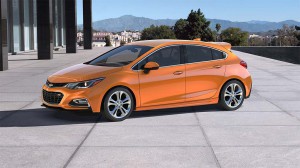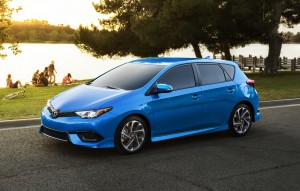
SUVs and crossovers seems to be dominating the market, but automakers are investing in hatchbacks, like the Elantra GT, as an alternative.
Can anything stop the steady growth of SUVs? Utility vehicles sales have risen dramatically since the end of the Great Recession, largely at the expense of sedans and coupes. But Hyundai, for one, is hoping to slow down that juggernaut and it’s turning to an unlikely SUV alternative: the hatchback.
Once a staple of the American market, hatchbacks were wildly popular back in the 1970s and ’80s, but demand slacked off, in part due to problems like water leaks and road noise. A few years ago, a hatchback fan would’ve struggled to find one on a U.S. dealer lot. But three- and five-door models are starting to regain some momentum as a growing number of brands reintroduce them to their line-ups, including Chevrolet, Honda and, now, Hyundai.
The Korean carmaker is just launching sales of the Elantra GT and Elantra GT Sport, and “I definitely hope they can prevent more migration” to sport-utility vehicles and crossover-utility vehicles, said Mike Evanoff, Elantra product planning manager, during a media briefing in the Detroit suburb of Ann Arbor on Thursday.
At their peak, hatchbacks accounted for about 10% of total U.S. new vehicles sales and, as recently as 1989, demand totaled more than 1 million a year. But sales started to slide in the decade that followed, dipping as low as 160,500 in 1998, equal to just 1.0% of the overall market, according to data collected by AutoPacific, Inc.
Demand actually started to rebound as the auto industry started its recovery in 2010, and, by 2014, sales again neared the million mark – 970,000 to be more precise. But AutoPacific analyst Dave Sullivan said he wonders if that turnaround is already losing momentum, the research firm projecting sales of hatchbacks will dip again to just 828,000 this year and fall to 689,000 by 2022.
Other observers are more upbeat. And that includes industry planners like Hyundai’s Evanoff and Ford Motor Co.’s Erich Merkle, who has described hatchbacks as the “nugget of hope” for the passenger car side of the ledger.
Ford offers 3- and 5-door versions of both its compact Focus and subcompact Fiesta models. Rival General Motors recently added a hatchback version of its Chevrolet Cruze. Honda has been expanding the availability of its Civic line with both a mainstream hatchback and the new high-performance Civic Type-R, a model until recently unavailable in the U.S.
So-called “hot hatches” were one of the rare bright spots for the segment during its big downturn, models like the Subaru WRX STi generating a loyal following by delivering solid performance at a relatively affordable price tag.
(As many as 20 models may vanish during ’18 model year. For the story, Click Here.)
The list of hot hatches has been on the rise. Ford recently added the 350 horsepower Focus RS version of its more familiar compact sedan. Volkswagen, which was one of the few brands to remain committed to hatchbacks, with its Golf and GTI models, also upped the performance ante a couple years ago with the addition of the 292 hp Golf R model.
For its part, Hyundai isn’t pushing quite that far, though it will offer two versions of the new Elantra hatchback: the mainstream, 160 hp Elantra GT and the turbocharged Elantra GT Sport, its turbocharged-four boosting that to 201 hp, while adding a more sporty multi-link rear suspension to improve handling.
The Korean carmaker is hoping to see the two hatches account for as much as 12 to 13% of Elantra’s U.S. volume and, Evanoff said, perhaps stabilize demand for what has been one of the brand’s best sellers, currently accounting for 27% of total Hyundai Motor America sales.
That is, if anything, a conservative guess, Evanoff later added, noting that Honda is forecasting the hatchback versions of the Civic will rise to a 15% share of the compact model’s overall U.S. demand.
Don’t expect to see the hatchback short-circuit the SUV onslaught, Evanoff acknowledged, but Hyundai is just one of many brands hoping the addition of 3- and 5-door models will slow the decline of conventional passenger cars.
(Click Here for more about Hyundai’s struggles in a changing market.)
Among the other manufacturers holding out hope are Mazda, with the Mazda3, and Toyota, which recently added the Corolla iM. All told, the number of hatch options available to U.S. buyers is now in double-digits for the first time in years.
The exact number – indeed, an accurate tally of hatchback sales – is not quite as easy to determine as one might suspect. That’s because a number of manufacturers still believe the word, “hatchback,” remains a turn-off to many buyers. So, they are prone to put models like the Mercedes-Benz GLA and Infiniti QX30 in the SUV or CUV columns, rather than describing them as hatches.
Whatever they’re called, manufacturers have taken a number of steps to improve the appeal and owner satisfaction of these products. Water leaks are a thing of the past, and during its presentation of the new Elantra hatchbacks, Hyundai took pains to explain how it has addressed noise and harshness issues.
Evanoff was also quick to point out that the two Elantra GT models actually offer substantially more cargo space – 55.1 cubic feet with the rear seats folded down — than such key utility vehicle competitors as the Mazda CX3, the Toyota CH-R and even the Audi Q3. The Chevy Cruze and Honda Civic Hatchback are close behind. All three of those models are actually shorter than their sedan alternatives yet all offer anywhere from 40 to 70% more cargo space than the four-door models.
On the downside, only a handful of hatchbacks offer the road-holding all-wheel-drive capabilities offered on most utility vehicles.
(First Drive: Honda Civic Type-R. Click Here for our review.)
The Elantra GT is the American version of what is sold in Europe as the Hyundai i30. While utility vehicles have been gaining momentum on the other side of the Atlantic, hatchbacks remain one of that market’s most popular body styles. With their added room, typical lower price generally better mileage, proponents hope that the latest crop of 3- and 5-door models will defy naysayers – and the flood of new SUV — and gain a bit of momentum in the American marketplace, as well.



